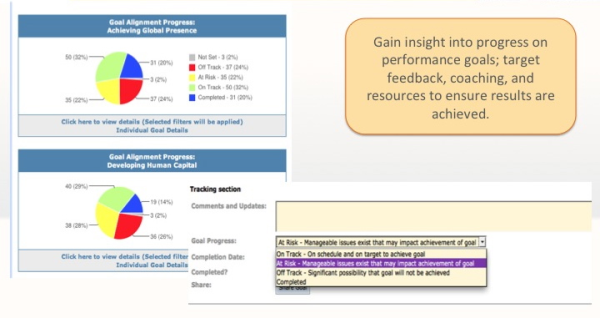7 Steps to Becoming a Performance Appraisal Process Rock Star!
 The performance appraisal meeting is, by far, the most dreaded part of the performance appraisal process. In order to handle the performance appraisal like a rock star, you must be doing the right things year round. The foundation for an effective performance appraisal meeting is built one stone at a time, throughout the course of the performance period.
The performance appraisal meeting is, by far, the most dreaded part of the performance appraisal process. In order to handle the performance appraisal like a rock star, you must be doing the right things year round. The foundation for an effective performance appraisal meeting is built one stone at a time, throughout the course of the performance period.
During performance planning, individual performance goals and measures are agreed upon. This process creates a mutually acceptable yardstick for evaluating performance effectiveness. Through the monitoring of performance and periodic performance update sessions, the employee acquires a clear understanding of interim performance. Thus, the path has been paved for reduced subjectivity and stress in the performance appraisal meeting.
Steps for Conducting a Successful Performance Appraisal Meeting
1. Prepare in advance.
Schedule time in your calendar to prepare for each performance appraisal. Gather all performance notes and documentation to assist you in completing your evaluation of performance. Be thorough and thoughtful in completing the evaluation of employee performance. Review employee job responsibilities and expectations. Compare actual performance to the performance standards and expectations. Questions to ask yourself:
- Am I looking at performance over the entire evaluation period?
- What performance standards were not met? List specific examples. What can be done to improve performance?
- What factors may have affected performance? What factors may have been beyond the employee's control?
- Were expectations reasonable? Attainable?
- What performance expectations were met? Exceeded? List specific examples.
- How have I formed my opinions about the employee's performance? Have I been fair and objective?
2. Provide a comfortable and professional environment.
The performance appraisal meeting is an important business discussion. As such, you should plan to hold the meeting in a professional and comfortable environment. Ideally, provide a conference room, versus your office or a restaurant. Why do managers believe that holding the performance appraisal discussion in a restaurant is a good idea? If you want to take an employee out to lunch go ahead and do it, just don’t conduct the performance appraisal meeting at lunch.
Plan to make yourself unavailable for any interruptions during the meeting. Your focus and attention should be on the employee, not other business issues, cell phone calls, text messages and the like.
3. Emphasize the future.
While an important aspect of performance appraisal is the review and documentation of accomplishments and overall performance for a given period of time, it is even more important to focus on the future. Remember that “what’s done is done,” and that the primary focus should be on the next performance period. During the discussion, place significant emphasis on how future performance objectives can be achieved and how standards can be met or exceeded. Past performance issues should be viewed as lessons for the future.
4. Start with the employee’s self-assessment.
Review the employee's self-evaluation to begin the meeting. Ask questions to ensure that you understand the employee's perspective and listen closely to employee responses. Provide supportive comments where your evaluation agrees with the employee’s. Also, comment on, but don’t review in detail yet, those areas where there may be disagreement.
 5. Review your evaluation and provide feedback.
5. Review your evaluation and provide feedback.
Review your evaluation of performance.
- Provide feedback on results that have been achieved and performance as compared to established performance standards.
- Highlight areas of agreement and then discuss areas where there may be disagreement. Share your specific observations, including examples, and the rationale behind your judgment.
- Give the employee the opportunity to share their perspective and provide facts or circumstances that affected their performance.
Employees are more likely to react favorably to positive rather than negative feedback, even when the employee is expecting negative feedback. As such, it is important to provide negative or critical feedback concerning employee performance in a way that is constructive and helpful. Constructive feedback is provided with the purpose of developing or enhancing the individual’s performance or changing behaviors. Destructive feedback provides little developmental direction for an employee and creates a relationship lacking trust, honesty, and compassion.
- Avoid destructive comments, accusation and blame.
- Offer specific, behavioral feedback rather than information that is unclear or wavering.
- Provide balanced feedback on both strengths and development needs.
- Offer support, assistance and access to necessary and available resources.
6. Set future performance goals.
In addition to covering the employee’s performance during the performance appraisal meeting, plans should be made to begin the next performance period. Employees should be given an opportunity to share their thoughts on future performance goals and managers should clearly communicate performance standards for the upcoming performance period.
Learn more about setting goals: Download - Six Ways to be SMART in Setting Performance Goals.
7. Create development plans to support performance improvement and professional development.
The final portion of the discussion should be devoted to discussing plans for the employee’s professional development and career growth. Employees should conduct a self-assessment of their strengths and development needs. Managers should initiate a discussion of continuing professional development, including:
- Assessment of the employee’s strengths and development needs in his or her present position,
- Plans for addressing needs and improving weaknesses in the present position, and
- Future responsibilities or assignments of interest.
Share this
You May Also Like
These Related Stories

3 Ways Self Appraisal Makes Life Easier for Managers

Calibrate, Don't Force in Employee Performance Management



